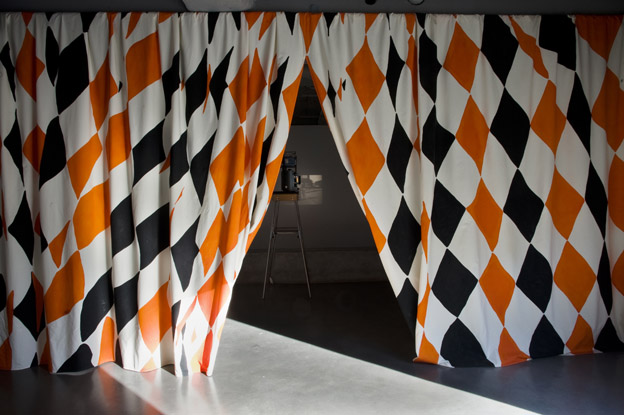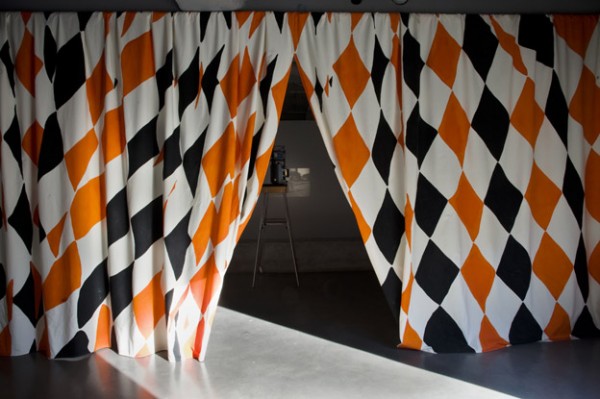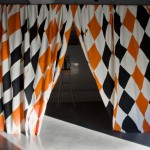Ulla von Brandenburg au Plateau

En franchissant le rideau qui constitue l’entrée de Name or Number, la récente exposition de Ulla von Brandenburg au Plateau à Paris, on ne peut s’empêcher de se remémorer ce fameux passage de Shakespeare : « Le monde entier est un théâtre / Et tous, hommes et femmes, n’en sont que les acteurs / Ils ont leurs sorties comme leurs entrées » (1).
Le passage de ce rideau, aux motifs de costume d’Arlequin, (Curtain II, 2008) est une évocation de la métaphore du Theatrum Mundi selon laquelle les êtres jouent tous, consciemment ou non, un rôle sur la scène d’un monde perçu comme jeu ou représentation, et dont les ficelles sont tirées par le démiurge de
l’œuvre qu’est la réalité ou sa mise en abyme fictionnelle. Le comédien, et le personnage qu’il incarne, reflètent l’image même du spectateur leurré, déjà acteur de l’univers. Cette illusion, et la tension latente de sa révélation, sont synthétisées dans l’effet miroir que propose la peinture murale Publikum (Audience, 2008). Cette peinture, placée vers la fin du parcours de l’exposition du Plateau, représente les spectateurs d’un théâtre fixant la scène, leur visage fantomatique se découpant dans un fort effet négatif sur un fond orange.
Si le concept de Theatrum Mundi a connu son apogée avec le baroque, l’univers scénique de Ulla von Brandenburg est un collage complexe d’éléments visuels créant une atmosphère sophistiquée et anxieuse de « fin de siècle ». Ce mouvement culturel de la fin du XIXe siècle anticipait les changements imminents de la modernité. Loin d’être empreint de nostalgie, le travail d’Ulla von Brandenburg examine notre contemporain à l’aune des peurs et des émotions intemporelles d’époques, où la recherche scientifique n’était pas séparée de la spiritualité et où les mécanismes, derrière les innovations technologiques, semblaient mystérieux et envoûtants. Ainsi, le monde de l’artiste est peuplé de fantômes, d’acteurs, d’adeptes du spiritisme ou de magie, et de personnages silencieux et figés tout droit sortis du théâtre d’Anton Tchekov ou d’August Strindberg. Ce carnaval de dandies et de femmes affectées prend la pose dans des tableaux vivants que l’artiste filme le temps d’une pellicule Super 8 ou 16mm. Silencieux, ces films en noir et blanc sont d’environ trois minutes et tournent en boucle. Les quelques oscillations souvent dues à la respiration des acteurs révèlent un jeu avec la notion d’instantané, dans une mise en parallèle critique du tableau vivant, des premiers développements de la photographie (le temps d’exposition) et de la peinture. Des films courts, jusqu’aux films plus récents possédant des travellings complexes comme 8 (2007) et Singspiel (2009), on retrouve toujours un catalogue de poses et de situations dont les dessins et peintures de l’artiste se font l’écho : le motif du visage caché dans les mains, celui du baiser, de l’alitement, du jeu de cartes, etc. Il est parfois possible d’identifier des sources historiques, comme la nature caravagesque du jeu de carte, cependant l’intensité dramatique de ces corps pétrifiés peut également se lire en lien à la modernité des gestes réduits, répétitifs et rituels des chorégraphies d’Yvonne Rainer ou de Hannah Halprin. L’artiste pose donc la question du mouvement et de la performativité des non-dits, en écho aux écrits de Goethe (et bien plus tard de Tchekhov), qui tentant de réduire le jeu de l’acteur à un ensemble de poses et de gestes, prescrivait une mobilité réduite pour les personnages importants .
Après avoir étudié la scénographie à Karlsruhe et travaillé dans le théâtre, Ulla von Brandenburg a intégré l’école d’art de Hambourg, dans l’atelier de Cosima von Bonin et elle utilise comme celle-ci une grande variété de médias (peinture, dessin, sculpture, film et performance). Chaque œuvre fonctionne de façon indépendante, mais agit également comme l’élément d’une narration plus vaste visant à déconstruire, non pas le contenu, mais l’histoire et le mode de fonctionnement de systèmes de production d’images comme le diorama, le théâtre, le tableau vivant, la photographie, ou encore l’illustration des jeux de tarot. Ulla von Brandenburg collectionne les images à la manière d’Aby Warburg ; elle utilise le montage-collision afin de créer un sous-texte constitué d’images réduites à des archétypes. L’artisanat féminin du quilt, référencé dans l’œuvre Quilt III (2008), est une métaphore parfaite de ce processus de montage. Ces images constituent des modèles dont elle extrait des détails et collectionne les poses. Il s’agit d’un système ouvert dont les connexions ont plus à voir avec l’inconscient qu’avec le hasard. Pour Ulla von Brandenburg, l’inconscient construit notre appréhension de la réalité. Les débuts de la psychanalyse, le développement des tests psychologiques comme ceux de Rorschach ou de Max Lüscher, de même que les recherches du professeur Charcot sont au cœur des préoccupations de l’artiste. Avec Forest III (2009), par exemple, un espace rond peint en noir à la manière d’un diorama dans lequel le visiteur s’immerge, l’artiste représente de façon abstraite une forêt de nuit, symbole de l’inconscient. Ce principe de glossaire de formes et d’associations a donné lieu à la création de journaux généralement distribués aux visiteurs des expositions. Nr. 3 (2006), par exemple, constituait une série de portraits sur le thème des fantômes, tandis que Nr. 4 (2008), distribué au Plateau, était le fac-similé d’un livre d’images du début du XXe siècle. De cette façon, le visiteur introduit ses propres associations et le système se répète : les motifs s’estompent et ressurgissent comme des revenants.
L’usage de la répétition participe à l’idée selon laquelle rien n’a de fin ni de commencement. Ce concept clé pour Ulla von Brandenburg apparaît sous la forme du ruban de Moebius dans le film 8 et se révèle dans l’usage systématique de la lecture en boucle. Selon l’artiste, la réalité est une construction faite d’illusions d’optique où rien n’est jamais déterminé. Ainsi, l’identité de ses personnages semble toujours transitoire, ils sont masqués, en transe, malades, ou hystériques. Formellement, cette instabilité est rendue par un processus d’abstraction et d’aplatissement produit par le filtre du passage constant d’un médium à l’autre. Les temporalités se superposent et se diluent dans une image (une pose) qui nie l’individualité des personnages. Le jeu des conventions sociales est mis à distance, pour révéler des sentiments intemporels, d’amour, de haine, de peur. Dans Singspiel, le dernier film de l’artiste, les personnages ne sont pas figés, ils fuient dès l’arrivée de la caméra. Leur caractère insaisissable se retrouve dans les portraits que l’artiste réalise en aquarelle sur papier de soie, ou dans les compositions « en creux » de peintures murales comme Publikum. Ainsi, que l’on soit acteur ou spectateur, Ulla von Brandenburg nous loge « à la frontière d’un état de conscience qui oscille entre le passé, le présent, la vie et la mort, le réel et l’illusion ».
Name or Number, Ulla von Brandenburg, Le Plateau, Frac Ile de France, Paris, du 19 mars au 17 mai 2009.
1: William Shakespeare – All the world’s a stage (from As You Like It 2/7)
All the world’s a stage,
And all the men and women merely players:
They have their exits and their entrances;
And one man in his time plays many parts,
english version :
As we pass through the curtain constituting the entrance of Name or Number , Ulla von Brandenburg’s recent exhibition at the Plateau in Paris, we cannot help
recalling Shakespeare’s famous words: “All the world’s a stage/ And all the men and women merely players/ They have their exits and their entrances.”
Our passage through this curtain (Curtain II, 2009) , decorated in the image of a Harlequin’s livery, is an evocation of the Theatrum Mundi metaphor, which holds that, consciously or not, all human beings play a role on the stage of the world, perceived as a game or representation and governed by its creator: reality, or its fictional mise en abîme. The actor, and the character he incarnates, reflects the image of the delusioned spectator, himself an actor in the universe. This illusion, and the latent tension of its potential disclosure, are fused in the mirror effect in the 2008 wall-painting Publikum (Public). Stationed toward the end of our itinerary through the Plateau exhibition, this painting portrays the spectators of a theater staring at the stage, their ghostly faces cut in negative against an orange background.
Although the Theatrum Mundi concept achieved its apogee in the baroque, Ulla von Brandenburg’s theatrical universe, a complex collage of visual elements, creates more of a “fin de siècle” atmosphere, sophisticated and anxiety-filled. At the turn of the 19th century, this cultural movement anticipated the imminent changes that modernity would bring. Far from create an imprint of nostalgia, Ulla von Brandenburg examines the contemporary through the timeless fears and emotions we associate with that earlier era, when scientific research was not separate from spirituality, and the mechanisms of technological innovation, still mysterious and bewitching. The artist’s world is populated by ghosts, actors, disciples of magic and spiritualism, silent and frozen characters straight out of an Anton Chekhov or August Strindberg play. This carnival of dandies and tormented women pose in the tableaux vivants the artist films over the duration of a roll of Super 8 or 16mm. Silent, these black and white shorts last about three minutes and are repeated on loop. Small oscillations, often due to breathing, reveal, via a parallel critique of the tableau vivant, a play with the notion of the instantaneous in the early developments of photography (shutter speed) and painting. Beginning with these short films and continuing on to more recent ones like 8 (2007) and Singspiel (2009), we discover a catalogue of poses and situations, echoed in the artist’s drawings and paintings: the motif of a face hidden by hands, of a kiss, a bedridden figure, a game of cards. Sometimes it is possible to identify their historical sources: the Caravaggesque nature of a game of cards, for example, even as the dramatic intensity of these petrified bodies simultaneously recalls a modernity of reduced, repetitive, and ritual gestures à la Yvonne Rainer or Hannah Halprin. The artist asks, then, the question of the movement and performativity of what is left unsaid, echoing the writings of Goethe (and much later on, Chekhov), which attempted to reduce the art of acting to an ensemble of poses and gestures, stipulating a reduced mobility for the lead roles.
After studying set design in Karlsruhe and working in theater, Ulla von Brandenburg entered the art school of Hamburg under the tutelage of Cosima von Bonin, and, like her teacher, worked across a wide range of media: painting, drawing, sculpture, film, and performance. Each work functions as an independent entity while serving as an element in a wider narrative: one aiming to deconstruct, not the content, but the history and functioning of systems of image production–the diorama, the theater, the tableau vivant, photography, even tarot card illustration. Ulla von Brandenburg collects images in the same way Aby Warburg did; she uses the montage-collision to create a subtext, constituted out of images that have been reduced to archetypes. The feminine craft of quiltmaking, referenced in the work Quilt III (2008), is a perfect metaphor for this practice of montage. Each image is a model, offering up details and poses for the artist to choose from. An open system emerges, one whose connections have more to do with the unconscious than with chance.
For Ulla von Brandenburg, the unconscious constructs our apprehension of reality. The birth of psychoanalysis, the development of psychological tests like the Rorschach or the Lüscher, even the studies of professor Charcot, lie at the heart of the artist’s preoccupations. Forest III (2009), which invites the viewer into a rounded, diorama-style space painted in black, offers an abstract representation of a forest at night, a symbol of the unconscious. The artist’s principle of a glossary of forms and associations has even inspired her to publish newspapers, typically distributed to the visitors of her exhibitions. Nr. 3 (2006), for example, consists of a series of portraits on the theme of the ghost, while Nr. 4 (2008), distributed at the Plateau, is the facsimile of a book of images from the turn of the 20th century. Confronted with these creations, the visitor introduces his own associations and the system repeats: the motifs die away and spring back to life, like the undead.
The use of repetition speaks to the idea that all things have neither a beginning nor an end. This concept, a key one for Ulla von Brandenburg, appears in the form of a Möbius strip in the film 8 and surfaces in her systematic use of the loop. According to the artist, reality is a construction composed of optical illusions, one where nothing is ever fully determinate. The identity of her characters always seems transient: they are masked, hypnotized, ill, hysterical. Formally, this instability is articulated through a process of abstraction and flattening, produced by a constant filtering of objects from one medium to another. Temporalities are superimposed, diluted into a single image (a pose) that denies the individuality of the characters. Social conventions are kept at a distance to make way for the timeless feelings of love, hate, and fear. In Singspiel, the artist’s most recent film, the actors are not paralyzed; instead, they flee at the very sight of the camera. Their elusive nature reappears in the aquarelle portraits she realizes on silk paper, or in her “hole” compositions in murals like Publikum. Whether we are actors or spectators, Ulla von Brandenburg lodges us “on the borders of different consciousness: past and present, alive and dead, and real and illusionary.”
articles liés
Leonor Serrano Rivas
par Mya Finbow
Flux de nos yeux
par Gabriela Anco
Electric Op
par Sandra Doublet



